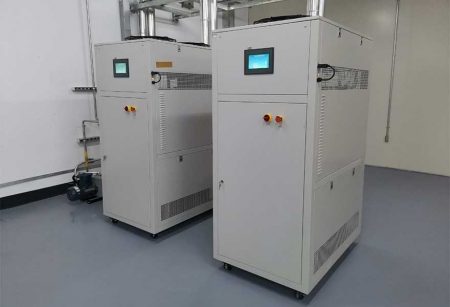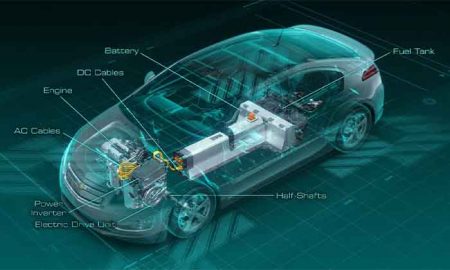Fuel Cell Cooling
Contattateci oggi stesso per la soluzione di controllo della temperatura perfetta
Cooling method of fuel cell stack
The energy conversion efficiency of the PEMFC reactor is about 50%, and the heat mainly comes from the entropy heat of the reaction and the irreversible heat of the electrochemical reaction. In order to ensure that the fuel cell operates at a suitable temperature, cooling methods must be used to remove heat.
1. Liquid coolant cooling
For high power (>5 kW) fuel cells and automotive fuel cells, liquid cooling is the most commonly used cooling method. Compared with air cooling, liquid cooling has the advantages of high heat transfer capacity and low flow rate. The liquid coolant can be deionized water or a mixture of water and glycol, or it can be a nanofluid containing nanoparticles.
2. Phase change cooling
Phase change cooling uses the enthalpy of vaporization to eliminate waste heat in the fuel cell. Its application in automotive cooling systems can be divided into heat pipe cooling and evaporative cooling.
Heat pipe cooling is to embed a heat pipe into a bipolar plate. In the absence of external power input, the heat pipe transmits a large amount of heat through the cross-sectional area for long-distance heat dissipation.
Evaporative cooling introduces liquid water into the flow channel and takes away the waste heat in the fuel cell through the phase change when the water evaporates.
3. Air cooling
Compared with other cooling methods, air cooling is the simplest cooling method. Air is transferred through the cooling plate or cathode to take away the waste heat generated by the fuel cell.
Through an overview of the above proton exchange membrane fuel cell cooling method, it is found that compared with traditional internal combustion engines, PEMFC has higher efficiency, which also means that when PEMFC is used in vehicles, more heat is emitted to the cooling system, requiring the selection of a more appropriate Cooling method. Air cooling only requires ambient air to pass through the battery cathode or an additional cooling plate between batteries. It requires minimal balancing equipment and the structure of the cooling system is relatively simple. Air cooling is mainly used in fuel cells with rated power less than 5 kW. When the power is greater, the heat dissipation requirements will become higher, and the heat dissipation needs of the fuel cell may not be met in actual applications. Therefore, air cooling is suitable for heat dissipation of small fuel cell stacks.
Compared to air cooling, liquid cooling is suitable for fuel cells with power ratings greater than 5 kW. Traditional liquid cooling uses water or a mixture of water and glycol as the coolant. In order to further improve its cooling performance, many scholars are currently studying nanofluid coolants to improve heat transfer intensity. Research results show that nanofluid coolants can further improve the heat dissipation capacity of fuel cells. At present, there are still some problems in the preparation, storage and pressure drop of the cooling process of nanofluid coolants that need to be solved. Evaporative cooling involves injecting liquid water into the cathode flow channel of the fuel cell for evaporation. Compared with other cooling methods, evaporative cooling can humidify the battery while dissipating heat. Finally, the evaporated water can be collected into a water tank for use. Moreover, evaporative cooling does not require an external humidifier or a separate cooling plate in the battery stack. Currently, the two most feasible cooling methods for high-power fuel cells such as fuel cell vehicles are liquid cooling and evaporative cooling.

Fuel cell thermal management control
PEMFC is a low-temperature fuel cell that can be used in automobiles, generators, submarines, etc. In fuel cells, stack temperature is an important performance parameter. Increased temperature will increase water activity, enhance electrochemical activity, reduce the ohmic potential of the membrane, aggravate the degradation of membranes and catalysts, and increase the output voltage of the fuel cell. , resulting in reduced battery stack performance. Low temperatures may cause water condensation and voltage loss at the electrodes. Since the exhaust temperature can only be around 70°C, about 95% of the heat needs to be taken away through cooling methods. Therefore, the heat dissipation of the fuel cell is relatively high, and its ideal operating temperature is about 60 to 80°C. Effective thermal management control strategies are key to ensuring the required operating temperature of fuel cells. Currently, people simulate fuel cells or study thermal management control strategies through experiments to ensure the operating temperature required for fuel cell operation.
1. Traditional PID control
The PID controller is a common feedback loop component in industrial control applications, consisting of a proportional unit (P), an integral unit (I), and a differential unit (D). Under dynamic conditions, the integrated temperature, battery polarization and hydration models of the compressor, humidifier and cooling system were simulated and controlled based on the current to achieve feedback PID control of the PEMFC stack temperature.
Traditional PID control has the advantages of flexible use, simple structure, and wide application range. At present, traditional PID control is widely used for PEMFC temperature control and is also one of the most commonly used control methods in industrial production. However, it has shortcomings such as slow response speed and long adjustment time.
2. Predictive control
Predictive control does not have high requirements on mathematical models, but it has good tracking performance and strong anti-interference ability.
As a coupled system with strong nonlinearity, multiple inputs and multiple outputs, the fuel cell has a working principle that makes it difficult for the traditional control algorithm to stabilize the system in a short time. Model predictive control (MPC) has a shorter stabilization time and fewer oscillations than PID control. In the PEMFC control system, it can well handle the constraints when designing the loop, and can suppress the impact of current disturbance on the output accuracy, which has certain guiding significance for realizing the stable operation of PEMFC under load disturbance state. However, when selecting the optimal MPC algorithm in practical applications, a long online calculation time is required.
3.Adaptive control
Adaptive control is a control method that can modify its own characteristics to adapt to changes in the dynamic characteristics of objects and disturbances. Adaptive inverse control is an adaptive control method that uses an adaptive filtering method to identify the inverse model of the controlled object and connects it to the input end of the object as a controller to control the dynamic characteristics of the object. Its advantage is that it can maximize the dynamic performance of the system. Excellent, while minimizing the impact of object disturbance. Compared with the traditional PID control method, adaptive inverse control can control the PEMFC temperature within the ideal temperature range, effectively reduce the overshoot of the system, reduce output voltage fluctuations, and significantly suppress overshoot during load changes. Real-time tracking control of the optimal temperature is achieved within the system, while the operating conditions are simple and easy to implement.
On the basis of adaptive control, adaptive inverse control can automatically track the dynamic changes of the fuel cell and achieve optimal control of battery temperature for the PEMFC system with time-varying parameters. Through simple four arithmetic operations, the control problem of the PEMFC system is solved. There is no need for complex nonlinear modeling and parameter identification, the calculation amount is small, and it is easy to implement in hardware. Compared with PID control, adaptive inverse control has shorter adjustment time and smaller voltage fluctuations, which is beneficial to the stable operation of the fuel cell, achieves optimal temperature control under different load conditions, and is helpful in finding the most suitable operating temperature for the fuel cell.
4. Fuzzy control
Fuzzy control is a kind of nonlinear intelligent control, a method that uses human knowledge to control the control object. It has the advantages of fast response speed, strong anti-interference ability, and good fault tolerance to changes in system parameters. It is especially suitable for For the control of nonlinear, time-varying, and hysteresis systems.
For PEMFC, a multi-input, multi-output nonlinear system, when adjusting temperature by controlling cooling water flow, fan speed and other parameters, the fuzzy temperature control strategy does not require an accurate mathematical model, so fuzzy control can better achieve temperature control. Compared with PID control, fuzzy control has fast response speed, strong anti-interference ability, and better temperature adjustment ability, but it is prone to static errors. Incorporating the integral link can eliminate static errors.
5. Collaborative control
It consists of a stack, a water tank and a radiator connected to a cooling fan and incorporates a model-based controller. The controller is composed of nonlinear feedback and linear quadratic regulator (LQR) state feedback. The fan speed and ambient temperature are used as inputs, and the stack outlet water temperature is used as output. The collected data shows that this control strategy can maintain the stack temperature variation within ±0.5°C.
Through the above control strategies, it can be found that the combination of different control strategies can better control the temperature of PEMFC. The combination of control strategies can overcome their own shortcomings, give full play to their respective advantages, and control the battery temperature more accurately.
6.Other controls
A state feedback control algorithm is applied to control multi-input and multi-output systems. This control algorithm is designed using the state space method. Four different control strategies are compared by controlling the radiator fan and bypass valve to reduce fuel cell parasitics. power effect. By adjusting the radiator cooling fan and controlling the coolant pump flow, the fuel cell operating temperature can be effectively controlled, and the cooling system has minimal cooling parasitic losses.

Conclusion
Although fuel cell thermal management control strategies have been applied accordingly, there are still many difficulties in achieving commercialization and application. Based on the current research status, the following conclusions can be drawn:
① The entropy heat of reaction and the irreversible heat of electrochemical reaction are the main sources of PEMFC heat. Although traditional cooling methods can meet the temperature control requirements, control strategies still need to be adopted in terms of stability, response speed, etc.;
②Although PID control can achieve temperature control, the traditional PID temperature control method still has some problems, such as poor anti-interference ability, slow response speed, etc.;
③PEMFC is a multi-input, multi-output system. A single control strategy can control the PEMFC temperature between 60 and 80°C. However, each control strategy has its own advantages and disadvantages and cannot achieve multi-faceted control of the fuel cell.
In future research, multiple control strategies can be used to control the temperature of the fuel cell to improve the performance of the fuel cell.
Forniamo progettazione e produzione di sistemi di controllo della temperatura completi. Da modelli standard a prodotti completi e personalizzati fino a 900 tonnellate. Siamo specializzati nell'assistenza ai clienti e ci dedichiamo ad aiutare ogni cliente ad avere il sistema di controllo della temperatura ottimale per le sue esigenze specifiche.
Forniamo soluzioni personalizzate non standard. Sono disponibili sia chiller a raffreddamento singolo che unità combinate di raffreddamento e riscaldamento.
E-mail: info@lneya.com ID WeChat: +8615251628237 WhatsApp: +86 17851209193
 LNEYA
LNEYA
 简体中文
简体中文


















































































